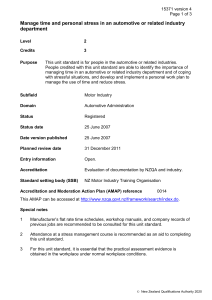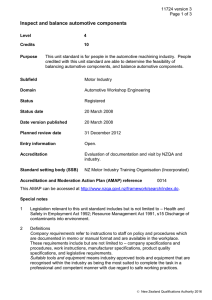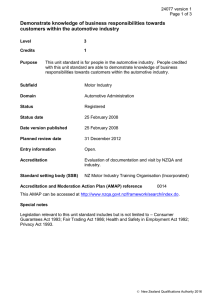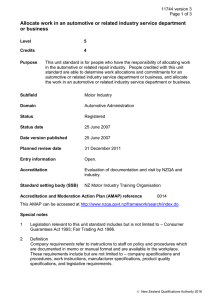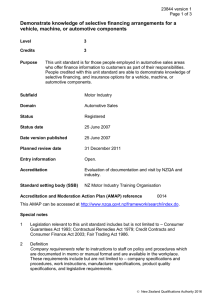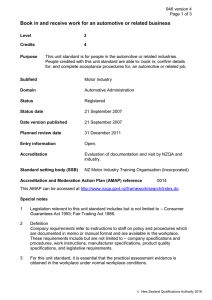Demonstrate knowledge of automotive oscilloscopes
advertisement
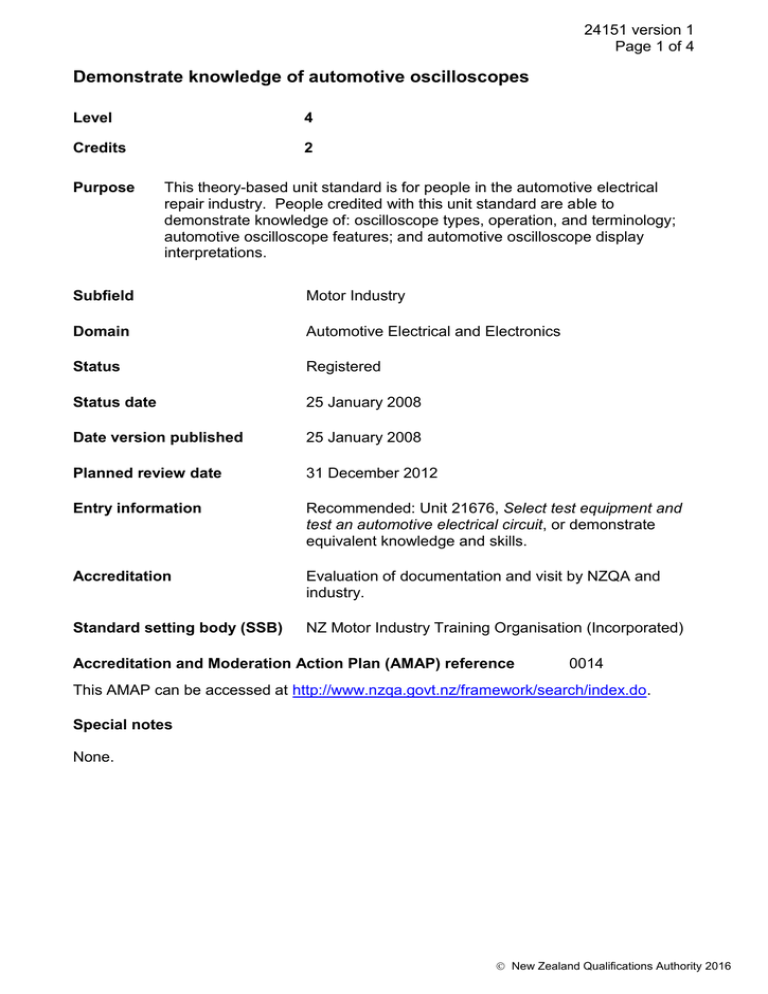
24151 version 1 Page 1 of 4 Demonstrate knowledge of automotive oscilloscopes Level 4 Credits 2 Purpose This theory-based unit standard is for people in the automotive electrical repair industry. People credited with this unit standard are able to demonstrate knowledge of: oscilloscope types, operation, and terminology; automotive oscilloscope features; and automotive oscilloscope display interpretations. Subfield Motor Industry Domain Automotive Electrical and Electronics Status Registered Status date 25 January 2008 Date version published 25 January 2008 Planned review date 31 December 2012 Entry information Recommended: Unit 21676, Select test equipment and test an automotive electrical circuit, or demonstrate equivalent knowledge and skills. Accreditation Evaluation of documentation and visit by NZQA and industry. Standard setting body (SSB) NZ Motor Industry Training Organisation (Incorporated) Accreditation and Moderation Action Plan (AMAP) reference 0014 This AMAP can be accessed at http://www.nzqa.govt.nz/framework/search/index.do. Special notes None. New Zealand Qualifications Authority 2016 24151 version 1 Page 2 of 4 Elements and performance criteria Element 1 Demonstrate knowledge of oscilloscope types, operation, and terminology. Performance criteria 1.1 The oscilloscope as a graph-displaying device is described in accordance with oscilloscope manufacturer specifications. Range 1.2 The uses of the screen grid and display controls to control and measure waveforms are described in accordance with oscilloscope manufacturer specifications. Range 1.3 vertical, horizontal, and trigger settings. Types of equipment and their set-up procedures are described in accordance with oscilloscope manufacturer specifications. Range 1.4 vertical (Y) axis representing voltage, horizontal (X) axis representing time, intensity (Z) axis representing display brightness. analogue, digital; set-up procedures – grounding, controls, probes. Oscilloscope terminology is described in terms of measurement and performance. Range waveform types – sine waves, square and rectangular waves, triangle and sawtooth waves, step and pulse shapes; waveform measurements – frequency and period, voltage, phase and phase shift; performance – bandwidth, rise time, vertical sensitivity, sweep speed, gain accuracy, time base or horizontal accuracy, sample rate, resolution, record length. New Zealand Qualifications Authority 2016 24151 version 1 Page 3 of 4 Element 2 Demonstrate knowledge of automotive oscilloscope features. Performance criteria 2.1 Features of automotive oscilloscopes are described in accordance with oscilloscope manufacturer specifications. Range includes but is not limited to – automotive software and updates, universal serial bus (USB) compatible port connection, protection against overloads and short circuits, high resolution, large memory, ability to capture multiple waveforms from various sensors at once, ease of operation, workshop-based and mobile, ability to test and measure wide range of electrical and electronic automotive components and circuits. Element 3 Demonstrate knowledge of automotive oscilloscope display interpretations. Performance criteria 3.1 An oscilloscope graticule is interpreted in terms of major and minor divisions. 3.2 Voltage measurements are interpreted in terms of voltage peak and peak-topeak voltage. 3.3 Time and frequency measurements are interpreted in accordance with the oscilloscope scale and screen area. 3.4 Rise time and pulse width measurement points are interpreted in terms of voltage percentages. 3.5 Phase shift measurements are interpreted in terms of cycle time or XY mode. Please note Providers must be accredited by NZQA, or an inter-institutional body with delegated authority for quality assurance, before they can report credits from assessment against unit standards or deliver courses of study leading to that assessment. Industry Training Organisations must be accredited by NZQA before they can register credits from assessment against unit standards. Accredited providers and Industry Training Organisations assessing against unit standards must engage with the moderation system that applies to those standards. New Zealand Qualifications Authority 2016 24151 version 1 Page 4 of 4 Accreditation requirements and an outline of the moderation system that applies to this standard are outlined in the Accreditation and Moderation Action Plan (AMAP). The AMAP also includes useful information about special requirements for organisations wishing to develop education and training programmes, such as minimum qualifications for tutors and assessors, and special resource requirements. Comments on this unit standard Please contact the NZ Motor Industry Training Organisation (Incorporated) info@mito.org.nz if you wish to suggest changes to the content of this unit standard. New Zealand Qualifications Authority 2016
